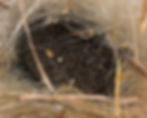Polar bears evolved from a common ancestor of the brown bear approximately 160 thousand to 4 million years ago (Cahill et al. 2013), during which brown bears stayed on land but polar bears diverged north to live on the sea ice. Through evolution they developed many adaptations which have allowed them to thrive in one of the harshest environments on earth. Of these adaptations, the one we will be focusing on today are their feet.
Like the rest of their body, polar bears have big, tough feet (also known as paws), which can grow up to 30cm across. The large size of their paws helps to distribute their weight when walking on thin ice or deep snow, just like snowshoes do for humans. Large paws are also beneficial when swimming, as they act like paddles.
Each paw has five black claws, which are short and thick. This is in comparison with their brown bear cousins who have long, light coloured and curved claws, primarily used for digging up soft earth to access roots and tubers to eat. Polar bear claws are primarily used for holding onto their slippery seal prey, but also help to provide traction on the ice. For female polar bears who use dens in which to have their cubs, strong claws are necessary for digging in frozen earth or ice.

To help their feet stay warm while navigating the arctic sea ice, thick fur grows all over their paws and even between the pads underneath. The hair also helps to provide additional grip on the ice.

The pads on their feet consist of the large metacarpal or palmar pad in the middle, the metatarsal or plantar pad at the back, then five digital pads on the toes (aka. toe beans). When looked at closely, you can see tiny bumps all over the pads. These tiny bumps, called papillae, act like suction cups, allowing for even more grip on the ice.


By far, the most fascinating aspect of a polar bear's feet is the role in which they play in communication (Owen et al, 2014). Due to the lack of scent-marking objects used by other bear species, such as trees or rocks, polar bears have developed a unique way of continuously spreading their scent. For each step a polar bear takes, their feet leave a small amount of scent on the ice. Known as chemical communication, this adaptation assists polar bears in understanding each other's location, movements and even reproductive status. This is particularly important in the spring when males seek out females to breed. Although it is not yet known whether a specific gland or simply urine on the feet is responsible for providing this information-rich scent, it is clear that their feet play a vital role in the polar bear's evolutionary success.


The images in this article are all from the bears in our care. Through positive reinforcement training and a trusting relationship, we were able to safely obtain the first measurements of Ganuk’s back feet, without using sedation. The tape measure shows a width of approximately 9 inches wide and 10 inches long, although this number is likely low due to the curled position of his foot.


References
Cahill, J.A., Green, R.E., Fulton, T.L., Stiller, M., Jay, F., Ovsyanikov, N., Salamzade, R., St. John, J., Stirling, I., Slatkin, M., Shapiro, B., (2013) ‘Genomic evidence for the island population conversion resolves conflicting theories of polar bear evolution’, PLoS Genetics, 9, 3.
Owen, M.A., Swaisgood, R.R., Slocomb, C., Amstrup S.C., Durner G.M., Simac, K., Pessier, A.P., (2014) ‘An experimental investigation of chemical communication in the polar bear’, Journal of Zoology, 295, 36-43.
North American Bear Center. https://bear.org/bear-tracks-and-trails/